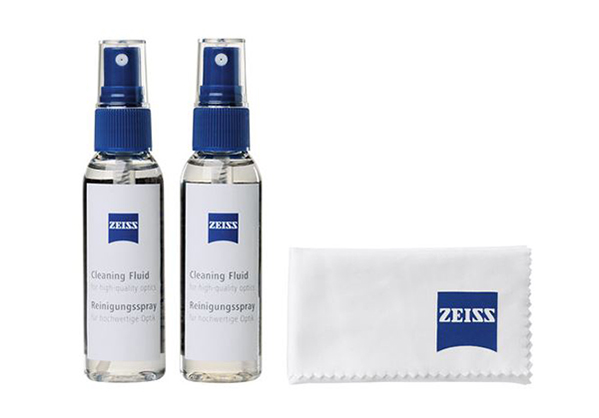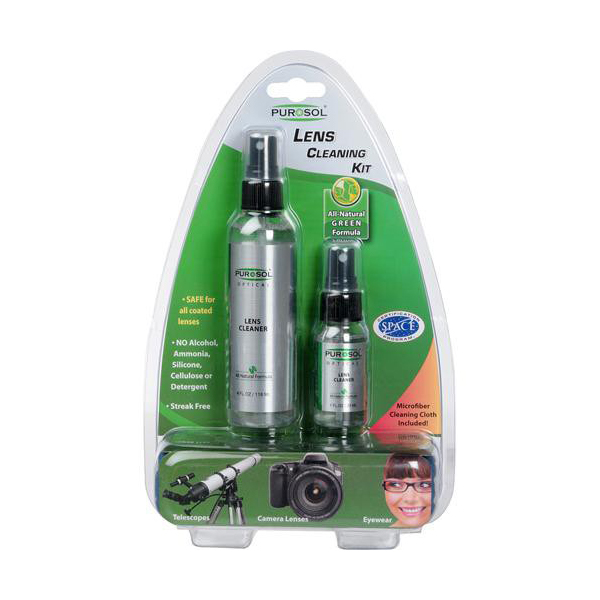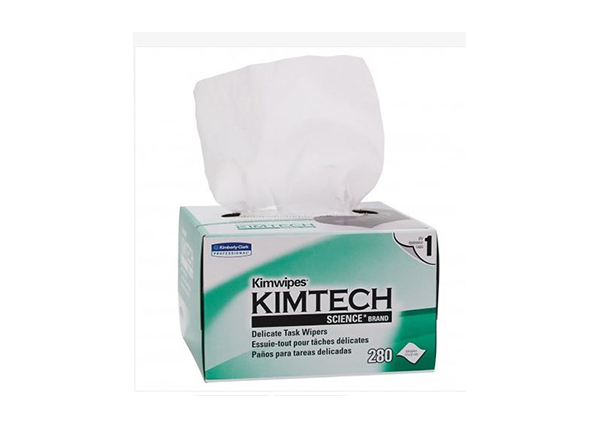Can You Use Eyeglass Cleaner On Camera Lens
Cleanliness is next to sharpliness, at least where camera lenses are concerned. A few specks of dust can be overlooked, but when the forepart element has been tagged with a thumbprint it's fourth dimension for cleaning.
There's an erstwhile joke that a sure brand of lenses are manufactured by grinding and grinding and grinding the glass—grinding and grinding until the give-and-take "Coca-Cola" disappears. While that probably isn't true, in that location's a lesson to exist learned yet. Rubbing anything on the surface of the forepart lens element is literally grinding away at the glass and coating. Under extreme magnification, a newspaper towel looks like sandpaper. Keep this in listen when you're tempted to wipe a lens with a shirttail or facial tissue.
Removing dust normally doesn't require any contact at all. Oft all it takes is a gentle puff of air to dislodge the specks. A seedling-type ear syringe works great—but be conscientious not to bear on the lens with the tip—it tin can get out marks. You can purchase an inexpensive accessory that combines a bulb with a soft camel hair brush (appropriately called a "blower brush"). Gently wipe the castor over the lens surface to remove the more stubborn particles. Store the blower brush in a nil-blazon sandwich purse to proceed it clean. Avoid brushes that are intended for other purposes, for instance makeup brushes. Those can shed bristles which can get caught in the mechanism.
Some people utilise canned compressed air. It works finer but should be used with extreme circumspection. Because it's under considerable pressure, the air can propel dust and dirt into the pocket-size seams effectually the lens chemical element. I don't recommend canned air for compact cameras that take congenital-in, disappearing lens covers because of the possibility that the force per unit area can damage one of the leaves of the comprehend.
Finger prints? I've seen some lenses that take so many fingerprints they wait like they're specimens left over from an episode of Forensic Files. What did you do, grab a handful of buttered popcorn before you lot screwed on the UV filter? If you do go a finger print on the front of your lens, get-go try removing information technology with a thick microfiber lens cloth. The microfiber textile has a special weave that captures dirt and oil, however is soft enough that it will not impairment the lens. Still, use a lite bear on. Microfiber cloths are great for wiping nose grease off of the LCD monitor on the back of your camera, too.

It'south rarely necessary to use liquid lens cleaner, but some fingerprints exercise require it. Apply distilled water or a cleaning fluid that is formulated for camera lenses and a fresh lens tissue. Put a single drib of fluid on the tissue (never on the lens) and gently wipe the lens surface in a circular motion.
What fluid?
Purosol Lens Cleaner was developed for NASA and military optics. It's non-toxic, hypoallergenic, nonflammable, sterile and completely biodegradable. It is free of Volatile Organic Compounds and exceeds EPA and OSHA health and safety standards, and the standards gear up for the European union, Australia, Canada, Japan. Information technology's the gold standard in my book. Ten dollars will become you a ane ounce spray canteen, or you can buy the kit shown here—which includes 4 ounce and once ounce bottles and a microfiber cloth for about $26.

Zeiss Lens Cleaner works great and costs less—about $12 for a pair of two ounce bottles, or $iii an ounce. I oasis't conducted any scientific tests, merely for my money it's the best for stubborn grease. They likewise offer pre-moistened Lens Cleaner Wipes which are convenient in the field and for travel.
What lens tissue?
Kimtech Kimwipes Wipers are the all-time, hands down. How tin you lot argue with a tissue that is labeled the "Fragile Task Wiper?" They'd been effectually for more than than 60 years and are used extensively in clean rooms and laboratories around the world. They are non expensive (nearly $2 per box of 280) and considering of their size (4.4 x eight.iv inches) they're easier to use than those sparse papers that come in many deal-bin lens cleaning kits.

The new tendency in lens blanket, for the front end element anyhow, is Fluorine, a chemical that is oliophobic (resistant to the adhesion of oil) so it resists fingerprints and grime. It'southward also quite durable and will survive properly conducted cleanings without excessive wearable.
—Jon Sienkiewicz
Source: https://www.shutterbug.com/content/how-clean-lens-and-what-use
Posted by: hamiltonbable1994.blogspot.com

0 Response to "Can You Use Eyeglass Cleaner On Camera Lens"
Post a Comment